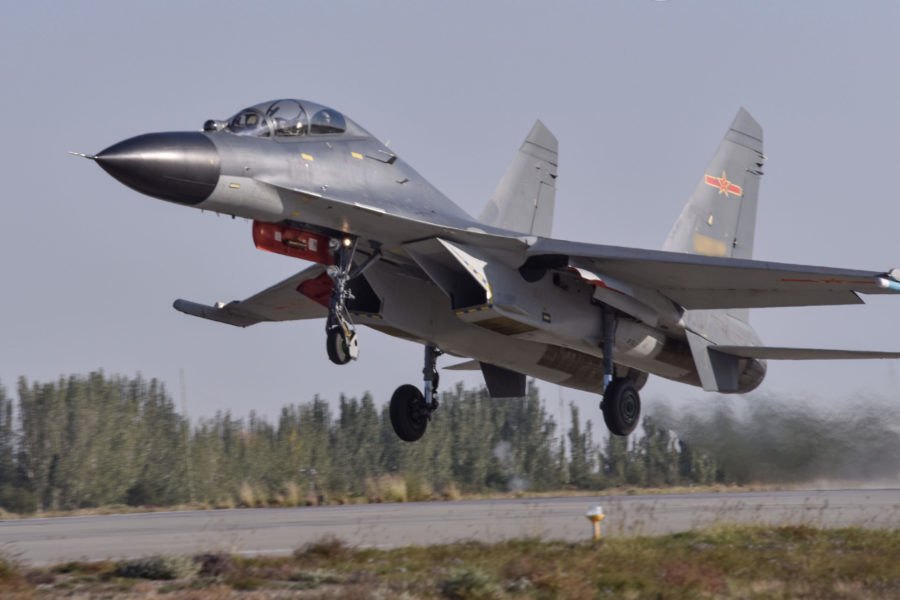The Pentagon’s new report on Chinese military power released Nov. 3 highlights a 2027 military modernization milestone that positions China for “credible military operations” against Taiwan.
“They’re preparing every contingency to unify by force,” noted a senior defense official briefing journalists on condition of anonymity ahead of the report’s release. The official said the defense analysis of China’s military strength in 2020 found a range of ways the country is preparing for a “Taiwan contingency,” including a newly defined 2027 military development milestone.
The first appendix of the nearly 200-page unclassified report to Congress breaks down the disparity between the People’s Republic of China and Taiwan’s military forces.
Of China’s total 1 million-person ground force, 416,000 are in the Taiwan Strait area compared to Taiwan’s 88,000 personnel. From an air standpoint, China maintains 800 fighters and fighter trainers in the eastern and southern theaters compared to Taiwan’s 500. China maintains a total force strength, including trainers, of 2,800 fighters.
The 2027 benchmark has been described by Chinese premier Xi Jinping as “intelligentized warfare.”
“It’s one where they say that the PLA’ s capabilities should be networked into a system of systems,” the official said, reflecting language often used to describe the U.S. military’s joint all-domain command and control (JADC2) effort.
“If they realize those goals for 2027, that would provide them with more credible military operations and the Taiwan contingency,” the official added.
Citing People’s Republic of China military literature, the official said options can begin with a “joint blockade campaign” and escalate to a full-scale amphibious invasion. Likewise, air missile strikes, cyber attacks, or a seizure of offshore islands near Taiwan are options China appears to be preparing for.
The official described China’s dual-pronged approach toward Taiwan as both preparation for invasion and to deter allies and partners such as the United States from intervening on Taiwan’s behalf.
“They often talk about to deter, or to compel Taiwan, to abandon moves toward independence,” he said. “But presently it appears to be that they’re preparing every contingency to unify by force and wanting to be able to deter, to delay, or otherwise to counter third-party intervention.”
‘Immediate Concerns’
The Pentagon classified as “immediate concerns” the so-called Taiwan contingency but notes that the PRC has developed a pressure campaign against the breakaway island since 2016. Aside from building a military force capable of invasion and quick victory, the campaign has included diplomatic isolation, military intimidation, and information and influence operations.
China has also put “pretty heavy pressure” on countries that maintain unofficial relationships with Taiwan to seize their engagement, and China disseminates misinformation about Taiwan on social media.
The defense official, however, deferred to the Intelligence Community as to whether China intends to mount an invasion of Taiwan in the near term. However, he did say U.S. efforts to strengthen deterrence and defend itself will continue.
“Any threat to undermine peace and security in the western Pacific would be of a grave concern to the United States,” he said, referencing the Taiwan Relations Act, the scope of which covers threatening activities beyond military action, to include economic blockades and embargoes against the island.
“The United States will continue to make available to Taiwan the defense articles and services necessary to enable Taiwan to maintain a sufficient self-defense capability,” a State Department spokesperson told Air Force Magazine on Nov. 4.
Since 2017, the U.S. has sold more than $19 billion in arms to Taiwan.
“The United States also supports Taiwan with training and encourages an innovative and asymmetric security posture,” the official added.
Air Incursions Raise Risk of Miscalculation
While the report covered only activities in 2020, the defense official said the massive air incursions by the Chinese air forces in October were a worrying development.
“Certainly, you can see that those were much higher than what we’ve seen before,” he said.
China flew nearly 150 aircraft over Taiwan’s southwest air defense identification zone over a four-day period, the largest such incursion ever.
“We are concerned about activities that might look like they’re aimed at intimidating Taiwan, that could be destabilizing or kind of increase the risk of some kind of miscalculation or incident,” he explained.
The official went on to describe the possible intent of the event.
“It presumably serves multiple purposes for them,” he said. “Sometimes I think what they’re aiming at is to try to intimidate Taiwan militarily. Sometimes, I think they may be trying to send a message to the United States, or to other allies and partners. They are also certainly trying to improve their training under sort of realistic conditions— that’s something that they write about a lot in their literature.”
The official said bomber flights in the region and other activities around Taiwan have demonstrated similar objectives.
“The PRC activity and the pressure they’re putting on Taiwan is only increasing,” he said—”therefore, as you know, potentially destabilizing and, I think, of growing concern to everyone.”
